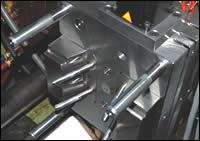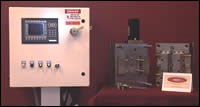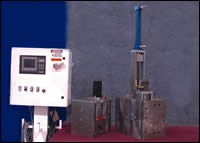Unscrewing Core Design Provides Fast, Accurate Core Positioning
Although PERC (Programmable Electric Rotating Cores System) is not a brand-new technology, it warrants a second look as a way for moldmakers to provide another value-added service to their customers.
|
Although PERC (Programmable Electric Rotating Cores System) is not a brand-new technology, it warrants a second look as a way for moldmakers to provide another value-added service to their customers. This programmable system that drives the unscrewing mechanism used to rotate cores in an injection mold has many benefits over hydraulic systems—including compactness, programmability, fast and accurate core positioning, and elimination of parts contamination with hydraulic oil. Moldmakers can order this system to integrate onto their mold just like they would a hot runner system. Developed by B A Die Mold (Aurora, IL)—a moldmaker specializing in processes like two-shot, thermoset and prototype molds—the patent-pending system opens up a whole new world of molding possibilities, according to B A Die Mold President Francine Petrucci. “When producing a threaded part, it may be necessary to first unscrew the part from the core so that you may eject the part from the mold without stripping or damaging the threads,” she explains. “Conventional unscrewing molds are hydraulically driven; therefore, the number and size of the threads on the part dictates the number of revolutions the core must rotate before the mold can open. The number of rotations necessary then determines the length of the hydraulic rack and the size of the hydraulic cylinder.” This is especially important when dealing with a part with numerous threads, Petrucci explains. “When you have a part with so many threads, the rack—which is mounted to the mold—has to be unrealistically long in order to unscrew the part from the core,” she notes. “A part which requires seven to 10 rotations could need a rack approximately five to 10 feet long, and a part which requires 20 turns could require a 16-foot long rack! In a conventional unscrewing mold you would then use gears to step down the length of the rack. This works with many threaded parts but not all. The gearing necessary can take up a lot of real estate in a mold base. This becomes an issue and creates limitations when there are other actions necessary for other features on the part or if the processor needs to fit the mold into a particular size press.” PERC eliminates the need for a rack—using a servo motor to rotate the core. Parts with an unlimited number of threads, intricate geometry or spacial requirements are now possible and practical, Petrucci adds. “Eliminating the hydraulic cylinder also eliminates the maintenance headaches as well as making it very sanitary for use in cleanroom and FDA situations,” she states. |
Related Content
-
MMT Chats: Marketing’s Impact on Mold Manufacturing
Kelly Kasner, Director of Sales and Marketing for Michiana Global Mold (MGM) talks about the benefits her marketing and advertising, MGM’s China partnership and the next-generation skills gap. This episode is brought to you by ISCAR with New Ideas for Machining Intelligently.
-
Women Impacting Moldmaking
Honoring female makers, innovators and leaders who are influencing our industry's future.
-
How to Improve Your Current Efficiency Rate
An alternative approach to taking on more EDM-intensive work when technology and personnel investment is not an option.









.jpg;maxWidth=300;quality=90)






